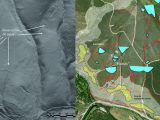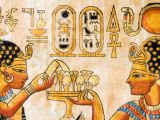A new paper in the Journal of Archaeological Science announces the discovery of a previously undocumented network of goldmines in Spain. The mines and the tunnels connecting them, now hidden under vegetation and crops, date back to ancient times.
Thus, researchers say that they were created some 2,000 years ago by Romans. What's interesting is that, by the looks of it, the Romans drew inspiration from the ancient Egyptians when working on this network of goldmines.
Using technology to find ancient goldmines
In the paper announcing this archaeological find, specialists detail that the goldmines and the accompanying system of tunnels were discovered with the help of a LiDAR (Light Detection and Ranging) system attached to a plane.
This technology, which boils down to scanning the ground and putting together a model of the forms identified during such surveillance activities, is the brainchild of scientists with NASA, who developed it to study sea ice in the Arctic and the makeup of oceans.
The first LiDAR system made its debut back in the 1960s. It proved so successful that, over the past few decades, folks interested in geology, archeology, topography and mapping have too embraced this technology.
In Spain, LiDAR technology made it possible to identify not just ancient goldmines and tunnels linking them, but also hydraulic systems and structures that Romans relied on to transport and store the water needed to support mining activities in the area.
The Romans sure loved gold
By the looks of it, the Romans were so committed to mining for gold in Spain's Eria valley that they went through the trouble to create channels and reservoirs, and even divert a local river, just to make sure mining activities would go as smoothly as possible.
What's more, they dug really deep into the ground looking to make the most of whatever gold was hidden in the area, Science Daily informs. Luckily for them, they didn't upset any fire-and-shadow sort of creature.
“The volume of earth exploited is much greater than previously thought and the works performed are impressive, having achieved actual river captures, which makes this valley extremely important in the context of Roman mining in the north-east of the Iberian Peninsula.”
“We have established that the labour that went into extracting the resource until its exhaustion was so intensive that after removing the gold from surface sediments, operations continued until reaching the rocks with the auriferous quartz veins underneath,” explains researcher Fernández Lozano.
Interestingly enough, archaeologists say that the Romans got most of their mining tricks from the ancient Egyptians. Thus, it appears that the systems and structures they used to carry and store water were copied after similar hydraulic works put together by the ancient Egyptians in North Africa.
According to historical records, Egyptians started using such systems and structures centuries before the Romans got into the habit of mining for gold. In several of his notes, Pliny the Elder, who was the Roman procurator entrusted with overseeing mining activities in Hispania, describes their work.
Hence, it's safe to assume that, as gifted as the Romans might have been on the battlefield, they did need some help when they took up mining. Luckily, 2,000 years ago, there weren't any copyright laws. Otherwise, the Romans would've been in serious trouble for ripping off the Egyptians.

 14 DAY TRIAL //
14 DAY TRIAL // 



